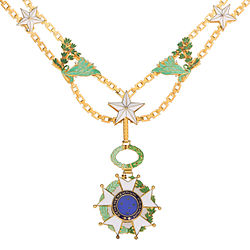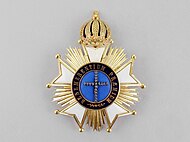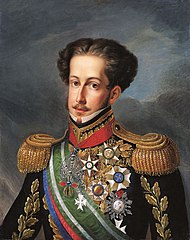Order of the Southern Cross
| National Order of the Southern Cross | |
|---|---|
 Grand Collar of the National Order of the Southern Cross
| |
| Awarded by the Government of Brazil and the Brazilian Imperial Family | |
| Type | National Order and dynastic order |
| Motto | Benemerentium Præmium |
| Eligibility | Foreign nationals |
| Awarded for | "As a token of gratitude and recognition for those who have rendered significant service to the Brazilian nation." |
| Status | Currently awarded |
| Founder | Pedro I of Brazil |
| Grand Master | The President of Brazil (the national order) |
| Chancellor | The Minister of Foreign Affairs |
| Grades | Grand Collar Grand Cross Grand Officer Commander Officer Knight |
| Statistics | |
| First induction | December 1, 1822 |
|
Ribbon bar of the National Order of the Southern Cross | |

Emperor Pedro I of Brazil founded the National Order of the Southern Cross (Portuguese: Ordem Nacional do Cruzeiro do Sul) as a Brazilian order of chivalry on 1 December 1822. The order aimed to commemorate the independence of Brazil (7 September 1822) and the coronation of Pedro I (1 December 1822). The name derives from the geographical position of the country, under the constellation of the Southern Cross and also in memory of the name – Terra de Santa Cruz (Land of the Holy Cross) – given to Brazil following its first arrival by Europeans in 1500.
History
Originally known as the Imperial Order of the Cross (Portuguese: Ordem Imperial do Cruzeiro), the Order was created by Emperor Pedro I on the day of his Coronation, 1 December 1822. Also on the same date the first knights of the order were appointed, to commemorate the crowning of the Empire's first monarch. After the proclamation of the independence of Brazil on 7 September 1822 other honorific awards had been made, but of the Orders of chivalry shared with Portugal, Brazilian branches of which had been created upon independence; the Order of the Cross, created to mark the Coronation of the Empire's founder, was thus also the first purely Brazilian Order.
After the fall of the monarchy, Brazil's first republican Constitution, enacted on 24 February 1891, abolished all titles of nobility and all Imperial Orders and decorations. The Order was later re-established by the government of Getúlio Vargas on December 5, 1932, as the National Order of the Southern Cross.

During the Old Republic period (from the Proclamation of the Republic until the Revolution of 1930), National Orders did not exist and the Brazilian State bestowed only military medals. Restored in 1932, the Order of the Southern Cross was the first Order to be created in the re-established, republican honours system. It is considered the senior Brazilian National Order.
During the Imperial period, the Order of the Southern Cross was not the highest ranking of the Imperial Orders, as it ranked below the Brazilian branches of the ancient orders of chivalry, that originated with Portugal: the Order of Christ (the senior-most Order), the Order of Saint Benedict of Aviz and the Order of St. James of the Sword. Those Orders were shared by Brazil and Portugal; the Order of Christ was shared with the Holy See similar to the Austrian and a Spanish Orders of the Golden Fleece. However among the Brazilian created Orders, the Imperial Order of the Cross ranked first, having higher status than the Imperial Order of Pedro I and the Imperial Order of the Rose.
The Imperial Order of the Cross continues to be used by both branches of the Brazilian Imperial Family as a House Order, awarded by the rival claimants to the position of Head of the Imperial Family, but such awards are not recognized by the Republic of Brazil.
Just like the Emperors of Brazil were ex officio Grand Masters of the Imperial Order, Presidents of Brazil are ex officio Grand Masters of the successor National Order. Accordingly, President Luiz Inácio Lula da Silva is the Order's current Grand Master.
Criteria



Unlike the Imperial Order, that was awarded to Brazilians and foreigners alike, the republican National Order is awarded to foreigners only. When the Order was re-established in by presidential decree on January 13, 1932, it was restricted to foreigners only with the stipulation that all awards of the Order constitute an act of foreign relations on the part of the Brazilian Government.

Brazilians were excluded deliberately. In the Old Republic, the State regarded Orders and decorations as contrary to the principles of republicanism, and thus maintained no honours system; the creation of an Order that would admit Brazilians to its ranks was a step too far. However, the Brazilian State also resented the lack of a decoration with which to honour foreign dignitaries, as is sometimes almost required by diplomatic protocol. For instance, during the celebrations of the Centennial of Brazilian Independence in 1922, several foreign dignitaries, including the King and Queen of the Belgians, came to Brazil for the celebrations. The King of the Belgians bestowed Belgian honours to some Brazilians. Brazilian nationals needed authorization from the Government to accept foreign titles of honour, or else face loss of citizenship, and under normal circumstances permission for the acceptance of appointment to Orders of Chivalry would not have been granted. While the government of Brazil relaxed its practice and authorized both accepting induction into foreign Orders and the wearing of foreign insignia, it lacked any decorations with which to reciprocate the Belgian gesture. The National Order of the Southern Cross was intended as an Order that would fill that gap. Today, accepting foreign honours and insignia without the need of prior Government approval is allowed, and several Brazilian Orders have been established to which Brazilians may be admitted, starting with the National Order of Merit (Ordem Nacional do Mérito), created in 1946. Even so, the governing statutes of the National Order of the Southern Cross have never been reformed, and it thus remains unavailable to Brazilians. Paradoxically, therefore, the Order's Grand Master — the sitting President of the Republic — is never a member of the Order he or she oversees, and the President's connection with the Order is severed once the President leaves office.
The Decree that re-created the Order (Decree 22.165, signed by Vargas on 5 December 1932) does not mention the creation of a new Order, but the reestablishment of the old Order of the Southern Cross, that had been "created upon the advent of the political independence of Brazil". This was done to improve the prestige of the Order by linking it with the past, that is, by associating it with an Order that had been created more than one century earlier.
In 1932, the republican version of the Order had the same five grades as the old imperial version. In 1939, by a statute issued on 17 July of that year, the additional grade of the Grand Collar was created. Until the creation of the Grand Collar, awards of which are restricted to Heads of State, the Grand Cross was the Order's highest rank.
Awards of, and promotions in, the National Order of the Southern Cross are made by decree of the President of the Republic, in his capacity as the Order's Grand Master. The decree of appointment or promotion is, like all presidential decrees, published in the Federal Government's Official Journal, and, as per the Order's regulations, the appointment or promotion is also recorded in a book kept by the Order's secretary.
The Brazilian Minister of Foreign Relations serves as the Chancellor of the Order, and an officer of the Ministry of Foreign Relations that heads the ceremonial and protocol division serves as the Secretary to the Order. The Order also has a Council, chaired by its Chancellor, that recommends awards and promotions.
Classes


Under its current regulations, the Order consists of the Grand Master and six Classes of members:
- Grand Collar: the recipient wears the adorned "Grand Collar", a chain from which the badge of the order is suspended. The recipient is also allowed to combine the wearing of the Grand Collar with any of the following insignia, or with both: the "Star" of the Order (a plaque modelled after the badge of the Order, to be worn on the left breast); and the Sash of the Order, that is proper to those of Grand Cross rank (a light blue sash, to be worn on the right shoulder). Awards of the Grand Collar are restricted to foreign Heads of State.
- Grand Cross: the recipient wears the Sash of the Order, and the badge of the Order hangs from the bottom part of that sash (given that the sash is worn on the right shoulder, the badge hangs close to the left leg, by the waist line). The recipient further wears the "star" of the Order, displayed on the left breast.
- Grand Officer: the recipient wears the badge of the Order around the neck suspended from a blue ribbon necklet, and the star of the order is displayed on the left breast.
- Commander: the recipient wears the badge of the order around the neck, suspended from a blue ribbon necklet.
- Officer: the recipient wears the badge of the Order on left breast suspended from a ribbon with a rosette.
- Knight: the recipient wears the badge of the Order on the left breast suspended from a simple ribbon.
| Ribbon bars | |||||
|---|---|---|---|---|---|
|
|
|
|
|
|
|
Notable recipients
Foreigners

- 2023 – Marcelo Rebelo de Sousa (President of Portugal)
- 2021 – Hamad Bin Isa Al Khalifa (King of Bahrain)
- 2021 – Tamim bin Hamad Al Thani (Emir of Qatar)
- 2021 – Mohammed bin Zayed Al Nahyan (President of the United Arab Emirates and Ruler of the Emirate of Abu Dhabi)
- 2021 – Mohammed bin Rashid Al Maktoum (Emir of Dubai)
- 2021 – Khalifa bin Zayed Al Nahyan (President of the United Arab Emirates)
- 2021 – Iván Duque (President of Colombia)
- 2020 – Taro Aso (Prime Minister of Japan)
- 2020 – Shinzo Abe (Prime Minister of Japan)
- 2018 – Benjamin Netanyahu (Prime Minister of Israel)
- 2017 – Okada Kōō (Spiritual leader of Sukyo Mahikari)
- 2017 – Horacio Cartes (President of Paraguay)
- 2017 – Stefan Zweig (novelist, playwright, journalist and biographer), posthumous award
- 2017 – Mauricio Macri (President of Argentina)
- 2016 – Rosen Plevneliev (President of Bulgaria)
- 2015 – Cristina Fernández de Kirchner (President of Argentina)
- 2015 – Enrique Peña Nieto (President of Mexico)
- 2014 – Julio de Vido (politician)
- 2013 – José Antonio Abreu (pianist)
- 2012 – Emmanuel Macron (later President of France)
- 2011 – Georgi Parvanov (President of Bulgaria)
- 2011 – María Ángela Holguín (Minister of Foreign Affairs of Colombia)
- 2010 – Bashar al-Assad (President of Syria)
- 2010 – Michel Suleiman (President of Lebanon)
- 2009 – Nicolas Sarkozy (President of France)
- 2009 – Arturo Valenzuela (Assistant Secretary of State for Western Hemisphere Affairs)
- 2007 – Anders Fogh Rasmussen (Prime Minister of Denmark)
- 2007 – Carl XVI Gustaf (King of Sweden)
- 2007 – Silvia Sommerlath (Queen consort of Sweden)
- 2007 – Henri (Grand Duke of Luxembourg)
- 2007 – Maria Teresa (Grand Duchess consort of Luxembourg)
- 2006 – Jacques Diouf (diplomat)
- 2004 – James Sherwood (businessman)
- 2004 – Mohammed VI (King of Morocco)
- 2003 – Beatrix (Queen of the Netherlands)
- 2003 – Harald V (King of Norway)
- 2003 – Sonja Haraldsen (Queen consort of Norway)
- 2003 – Yasuo Tanaka (governor of Nagano)
- 2003 – Ann Hartness (scholar)
- 2002 – Ismael Crespo (Professor at the University of Murcia, Murcia, Spain)
- 2002 – Aleksander Kwaśniewski (President of Poland)
- 1999 – Alberto Fujimori (President of Peru)
- 1999 – Albert Fishlow (professor)
- 1999 – Giovanni Sartori (political scientist)
- 1998 – Ricardo Salgado (banker)
- 1998 – Manuel Fraga (president of Galicia)
- 1996 – Jacques Chirac (President of France)
- 1996 – António Guterres (Prime Minister of Portugal)
- 1996 – Stephan Schmidheiny (entrepreneur)
- 1995 – Ronald Venetiaan (President of Suriname)
- 1991 - Sofía of Spain (Queen consort of Spain)
- 1991 – Juan Carlos I (King of Spain)
- 1990 – Václav Havel (President of Czechoslovakia)
- 1990 – Daisaku Ikeda (president of the Soka Gakkai)
- 1987 – Mário Soares (President of Portugal)
- 1984 – Kiyoshi Sumiya (Ambassador of Japan)
- 1978 – Charles, Prince of Wales (later Charles III, King of the United Kingdom and the other Commonwealth realms)
- 1976 – Masayoshi Ōhira (Finance Minister of Japan)
- 1976 – Valéry Giscard d'Estaing (President of France)
- 1975 – Nicolae Ceausescu (President of Romania)
- 1974 – Margrethe II (Queen of Denmark)
- 1972 – Hugo Banzer (President of Bolivia)
- 1972 – Alexander II Karađorđević (Crown Prince of Yugoslavia)
- 1969 – Neil Armstrong (astronaut)
- 1969 – Michael Collins (astronaut)
- 1968 – Elizabeth II (Queen of the United Kingdom and the other Commonwealth realms)
- 1965 – Mohammad Reza Pahlavi (Shah of Iran)
- 1964 – Charles de Gaulle (President of France)
- 1964 – Felix Grant (radio presenter)
- 1963 – Blaže Koneski (writer)
- 1963 – Ivan Rukavina (Army general)
- 1963 – Josip Broz Tito (President of Yugoslavia)
- 1962 – Prince Philip, Duke of Edinburgh (consort of the British monarch)
- 1961 – Che Guevara (revolutionary)
- 1961 – Yuri Gagarin (cosmonaut)
- 1960 – Sarit Thanarat (Prime Minister of Thailand)
- 1960 – Bhumibol Adulyadej (King of Thailand)
- 1958 – Haile Selassie (Emperor of Ethiopia)
- 1956 – David Rockefeller (banker)
- 1956 – Sukarno (President of Indonesia)
- 1955 – Hirohito (Emperor of Japan)
- 1954 – Dwight D. Eisenhower (Supreme Commander WWII, President of the United States)
- 1954 – Vera Weizmann (wife of Chaim Weizmann, the first President of Israel)
- 1952 – Helen Keller (activist)
- 1952 – Eva Perón (First Lady of Argentina)
- 1946 – Nelson Rockefeller (as Assistant Secretary of State for American Republic Affairs, later U.S. Vice President)
- 1944 – Charles Lyon Chandler (historian)
- 1944 – Chiang Kai-shek (Chairman of the National Government of China)
- 1944 – Ira C. Eaker (general of the United States Army Air Forces)
- 1944 – Douglas Fairbanks Jr. (Naval officer)
- 1940 – Eleazar López Contreras (President of Venezuela)
- 1940 – Robert B. Williams (pilot)
- 1940 – Conrad Carel Käyser (Marine officer and explorer)
- 1935 – Jean Batten (aviator)
- 1933 – Edward, Prince of Wales (later Edward VIII, King of the United Kingdom and the British Dominions, Emperor of India)
- 1884 – Nicholas II (Emperor of Russia)
- 1878 – Wilhem II (German Emperor and King of Prussia)
- 1873 – Carlos I (King of Portugal and the Algarves)
- 1871 – Albert Edward, Prince of Wales, (later Edward VII, King of the United Kingdom and the British Dominions, Emperor of India)
- 1867 – Prince Alfred (Duke of Saxe-Coburg and Gotha)
- 1866 – Alexander III (Emperor of Russia)
- 1865 – Maximilian I (Emperor of Mexico)
- 1864 – Gaston, Count of Eu (French prince)
- 1861 – Luís I (King of Portugal and the Algarves)
- 1855 – Pedro V (King of Portugal and the Algarves)
- 1852 – Domingo Faustino Sarmiento (President of Argentina)
- 1848 – Isabella II (Queen of Spain)
- 1838 – Fernando II (King of Portugal and the Algarves)
- 1830 – Francis II & I (Holy Roman Emperor and Emperor of Austria)
- 1830 – Marie Louise (Duchess of Parma, former Empress of the French)
- 1830 – Domingos Sequeira (artist)
- 1826 – John Pascoe Grenfell (admiral)
- 1826 – Maria II (Queen of Portugal and the Algarves)
- 1823 – Thomas Cochrane, 10th Earl of Dundonald (admiral)
among others
Brazilians
- 1888 – Afonso Celso, Viscount of Ouro Preto (Prime Minister of Brazil)
- 1876 – José Paranhos, Baron of Rio Branco (Diplomat)
- 1870 – José Paranhos, Viscount of Rio Branco (Prime Minister of Brazil)
- 1866 – Francisco Manuel Barroso, Baron of Amazonas (Admiral)
- 1870 – Deodoro da Fonseca (Marshal)
- 1869 – Manuel Luís Osório, Marquis of Erval (Marshal)
- 1852 – Manuel Marques de Sousa, Count of Porto Alegre (Lieutenant general)
- 1841 – Luís Alves de Lima e Silva, Duke of Caxias (Marshal)
- 1841 – Honório Hermeto Carneiro Leão, Marquis of Paraná (Prime Minister of Brazil)
- 1837 – Pedro de Araújo Lima, Marquis of Olinda (Regent of the Empire)
- 1824 – Carlos Frederico Lecor, Viscount of Laguna (Governor of the Cisplatina province)
among others
Cities
- 2016 – Medellín (Honorable support due LaMia Flight 2933 accident)




